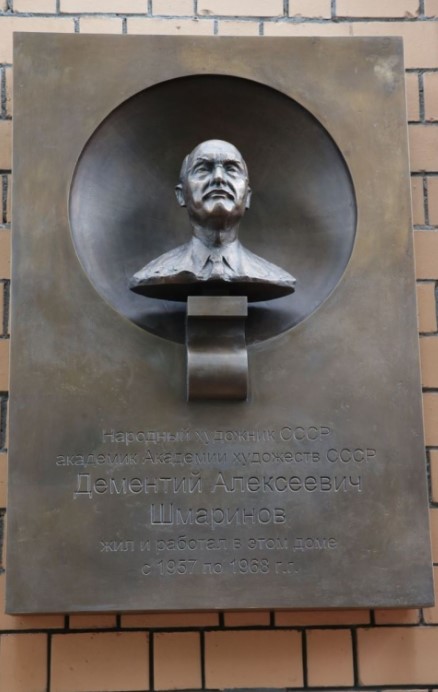Dementiy Alekseevich
Shmarinov
1907-1999

Dementiy Alekseevich Shmarinov was a soviet painter, graphic artist, teacher. He was one of the most significant and famous illustrators of the Soviet book. He was a member of the Union of Artists of the USSR, Honored Artist of the RSFSR (1945), people’s Artist of the USSR (1967). Since 1953 he was a full member of the Academy of Arts of the USSR (then the Russian Academy of Arts). He was a corresponding member of the Academy of Fine Arts in Berlin (1970, GDR), laureate of the Stalin Prize of the second degree (1943), the Lenin Prize (1980) and the Prize of the President of the Russian Federation in the field of culture and art (1997). Dementiy Alekseevich Shmarinov was born in Kazan on April 29, 1907 in the family of an agronomist. He studied at the Kiev studio of N.A. Prakhov (1919-1922) and in Moscow, at the studio school of K.P. Chemko (1923-1928), where his mentor was D.N. Kardovsky. He lived and worked in Moscow. He worked mainly in the field of book graphics. Since 1927, Shmarinov began working at the State Publishing House as an illustrator of children’s books. He was a member of the Society of Book Artists (1931). He tried his hand at monumental painting (1938-1939). As a part of a team of artists, he executed decorative monumental and propaganda panels “Masters of Stakhanov’s Harvests” at the VSHV, as well as “Notable People of the Soviet Country” at the World Exhibition in New York (not preserved). He gained fame, first of all, as a book artist – starting with illustrations for the “Life of Matvey Kozhemyakin” by M. Gorky, which he created in contact with the author. In the conditions of a total reversal to traditionalism, the artist turned to the “domiriskusnicheskoy” stylistics of the time of P. P. Sokolov; he created monochrome drawings in black watercolor or charcoal, which are the most expressive and valuable among his works. However, among his rather conservatively romantic illustrations, there are wonderful cycles, impressive for their hopeless – unique for the official art of those years – tragedy or bravura-dramatic pathos. These are, respectively, the drawings for “Crime and Punishment” (1935-1936) and “Peter the Great” by A. N. Tolstoy (1940-1945). They are joined by detailed historical illustrations to “War and Peace” by L. N. Tolstoy (1953-1955). Shmarinov worked as an easel artist, the most famous for his easel painting and graphics on the theme of the Great Patriotic War (a series of drawings “We will not forget, we will not forgive!”, 1942; the painting “On the conquered land”, 1944-1945). From the first days of the war, he began working on a poster, in a new area for himself. He was in the first row of those artists who made a breakthrough in the development of our poster in the direction of emotionality, the deepening of the image, the rejection of the conditional, supposedly “specific poster”, schematism of form. Such posters as “Revenge!” with the image of a mother holding a murdered child in her arms, or “I’m waiting for you, warrior-liberator!” – with a touching image of a boy, have high emotional efficacy. He created a number of bright anti-fascist posters imbued with the pathos of the struggle for liberation: “All forces to defend the city of Lenin!”, “Fascists will not pass”, “Crush the fascist monster” (both -1941), “Take revenge”, “Soldier of the Red Army! Repay the enemy for the blood and tears of the Soviet people!”, “Go ahead to defeat the enemy!”, “Warrior, answer the Motherland with victory!”. Throughout his creative life, he successfully designed the most famous works of Russian and foreign classical literature: A.S. Pushkin (“Belkin’s Stories”, 1937; “The Queen of Spades”, 1976), M.Y. Lermontov (“Hero of Our Time”, 1941), U. Shakespeare (“Romeo and Juliet”, 1959-1960; “Twelfth Night”, 1964), N.V. Gogol (“Taras Bulba”, 1969) and other authors, and in monochrome techniques (charcoal and black watercolor) he always achieved greater expressiveness than in those rare cases (Shakespeare) when he used color. Of his later works, drawings for the novel by E. Hemingway “For Whom the Bell Tolls” (1979) received special fame during the “thaw-stagnation” period. He was awarded a Gold medal at the International Book Exhibition in Leipzig (1959). He led a creative graphics workshop in Moscow (1962-1966). In 1965 he made a trip to Italy, performing many full-scale sketches there. Serving as Chairman of the Board of the Moscow Branch of the Union of Artists of the RSFSR (1959-1961, 1966-1968, 1972-1973), he earned a reputation as a cautious but successful leader. In 1989 his book “Years of Life and Work” was published.
Address: Moscow, Begovaya str., 7

